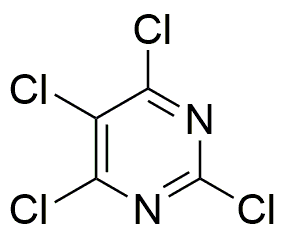2,4,5,6-Tetrachloropyrimidine is widely utilized in research focused on:
- Pesticide Development: This compound serves as a key intermediate in the synthesis of herbicides and fungicides, helping to protect crops from pests and diseases, thus enhancing agricultural productivity.
- Pharmaceutical Research: It is used in the development of various pharmaceuticals, particularly in the creation of antiviral and anticancer agents, contributing to advancements in medical treatments.
- Material Science: The compound is employed in the formulation of specialty polymers and coatings, providing enhanced chemical resistance and durability for industrial applications.
- Analytical Chemistry: It acts as a standard reference material in analytical methods, aiding researchers in the accurate quantification of similar compounds in environmental samples.
- Biochemical Studies: This chemical is utilized in biochemical assays to study enzyme inhibition and receptor binding, facilitating research in biochemistry and molecular biology.
General Information
Properties
Safety and Regulations
Applications
2,4,5,6-Tetrachloropyrimidine is widely utilized in research focused on:
- Pesticide Development: This compound serves as a key intermediate in the synthesis of herbicides and fungicides, helping to protect crops from pests and diseases, thus enhancing agricultural productivity.
- Pharmaceutical Research: It is used in the development of various pharmaceuticals, particularly in the creation of antiviral and anticancer agents, contributing to advancements in medical treatments.
- Material Science: The compound is employed in the formulation of specialty polymers and coatings, providing enhanced chemical resistance and durability for industrial applications.
- Analytical Chemistry: It acts as a standard reference material in analytical methods, aiding researchers in the accurate quantification of similar compounds in environmental samples.
- Biochemical Studies: This chemical is utilized in biochemical assays to study enzyme inhibition and receptor binding, facilitating research in biochemistry and molecular biology.
Documents
Safety Data Sheets (SDS)
The SDS provides comprehensive safety information on handling, storage, and disposal of the product.
Product Specification (PS)
The PS provides a comprehensive breakdown of the product’s properties, including chemical composition, physical state, purity, and storage requirements. It also details acceptable quality ranges and the product's intended applications.
Certificates of Analysis (COA)
Search for Certificates of Analysis (COA) by entering the products Lot Number. Lot and Batch Numbers can be found on a product’s label following the words ‘Lot’ or ‘Batch’.
*Catalog Number
*Lot Number
Certificates Of Origin (COO)
This COO confirms the country where the product was manufactured, and also details the materials and components used in it and whether it is derived from natural, synthetic, or other specific sources. This certificate may be required for customs, trade, and regulatory compliance.
*Catalog Number
*Lot Number
Safety Data Sheets (SDS)
The SDS provides comprehensive safety information on handling, storage, and disposal of the product.
DownloadProduct Specification (PS)
The PS provides a comprehensive breakdown of the product’s properties, including chemical composition, physical state, purity, and storage requirements. It also details acceptable quality ranges and the product's intended applications.
DownloadCertificates of Analysis (COA)
Search for Certificates of Analysis (COA) by entering the products Lot Number. Lot and Batch Numbers can be found on a product’s label following the words ‘Lot’ or ‘Batch’.
*Catalog Number
*Lot Number
Certificates Of Origin (COO)
This COO confirms the country where the product was manufactured, and also details the materials and components used in it and whether it is derived from natural, synthetic, or other specific sources. This certificate may be required for customs, trade, and regulatory compliance.


